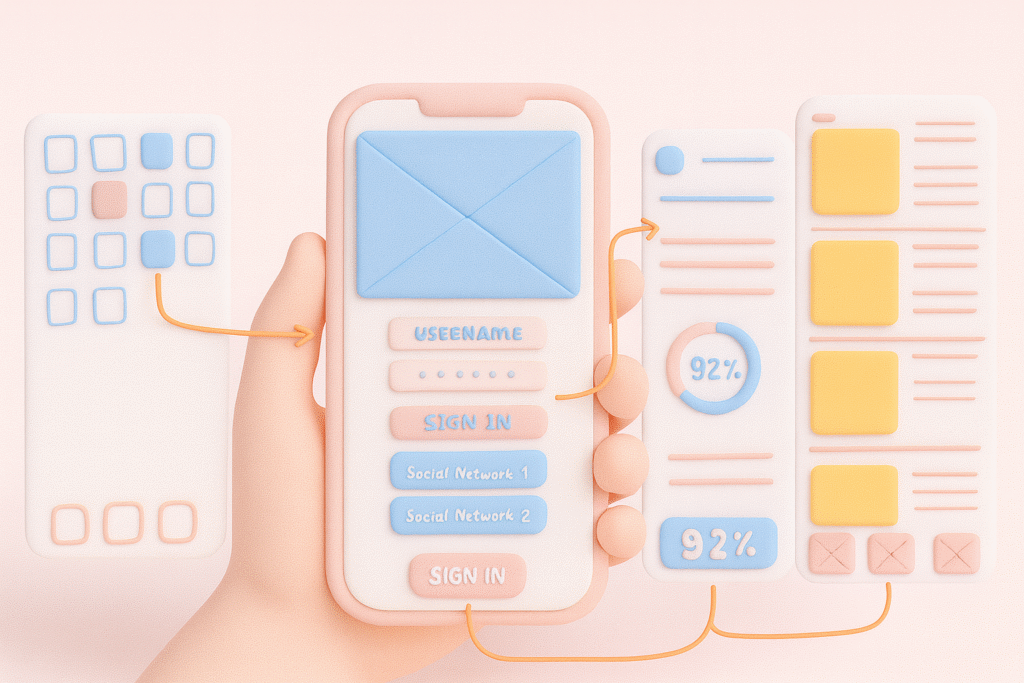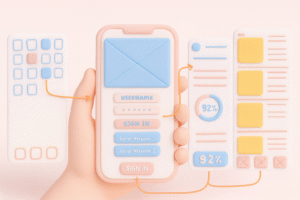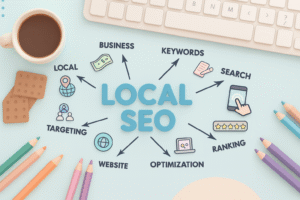“User experience” is a single word that defines the success of any online product in the modern digital environment, be it a website, an app, or even a SaaS platform.
UX design (user experience design) has transformed into a nice-to-have basis of human perception and interaction with technology.
Great UX is intangible; it just works, showing the users a way out of the complex tasks in an intuitive way.
What Is UX Design?
In its simplest form, UX design revolves around how a user experiences interacting with a digital product. It is the art of designing products that deliver meaningful and relevant experiences.
It entails the cognizance of the user behavior mapping, user journey testing, interactions, and refining each component that influences their satisfaction and usability.
An effective UX designer needs to be more than merely a visualist. It’s not merely about the appearance but about the functionality.
How do you navigate the content, the structure, and the hierarchy and accessibility? The interaction flow.
All of these are very important; the final result is to match the functionality of the product with the aims of the user and eliminate friction and confusion.
The Importance of UX Design Like Never Before
In the age of digital overload, users have infinite choices. One negative experience can make them leave and stay away forever.
A good UX design will keep them on and loyal through clarity, trust, and emotional appeal.
Further good UX leads directly to business metrics. It has also been found that companies that invest in UX perform more successfully than their competitors in terms of customer retention, conversion rate, and perception of the whole brand.
UX is directly measurable as a business asset and not just a creative concept.
The Fundamental Guidelines for an Excellent UX Design
Although UX design may appear to be complicated, the most successful products may adhere to a number of common rules.
User-Centered Thinking
Any UX design must be grounded in empathy and thorough research. The empathy approach is the basis of good UX.
It enables designers to feel the product as the user does, to find solutions that are really useful to that person. Empathy and research will help to create an intuitive, engaging, and relevant product for its audience.
Consistency Patterns and Tone
Consistency is an important aspect of a good design. Repetition of the visual patterns, Interface design elements, and communication patterns will allow users to develop familiarity and confidence when interacting with a product.
When the button icons and layout behave in a consistent manner, users will spend less cognitive load trying to figure out how to interact with the system. A consistent tone of the content also fosters brand identity and helps make the content easier to understand.
Accessibility
Inclusive design is a design approach that ensures that all users, including users with disabilities, can engage with a product without any problems.
Accessibility is not just a moral imperative but one of the main elements in achieving a wider customer base and enhancing the overall usability.
One of the best ways of approaching the design task is to consider the needs of a wider audience when designing a product, and this is what makes inclusiveness most effective as a design approach by making sure that the product can be used by all users and that it can be modified to suit the various needs of users. Accessibility is a key attribute of a design task.
Responsiveness
Having a responsive system means that the system will respond to user input in the correct way, which will give a user the impression that the system has heard the user.
Providing feedback in the form of animation confirmations or error messages will make the system feel responsive and encourage the user to put in more input.
Simplicity
The most successful designs are simple. All features, clicks, and gestures must be consciously utilized. Unnecessary complexity will only frustrate the user and distract them from their agenda. By eliminating noise and truly focusing on clarity, designers can create seamless, effective, and pleasant user interfaces.
These principles can make any product either functional or entertaining and create a smooth
ride, which the users automatically have confidence in.
The Process of UX Design
Usually, the UX design process is done in an iterative process with several important steps.
- Research: This phase aims to gather useful information regarding the pain points and goals of the user. Designers may conduct interviews, survey analytics, and do competitive analysis to gain a profound insight into the needs and expectations of users.
- Analysis: During this stage, designers come up with user personas and visualize user journeys to understand how various individuals engage with the product. This is useful in identifying areas of difficulty and areas of enhancement.
- Design: In this case, the designers develop wireframe prototypes and interaction flows, which convert ideas and research results into viable visual solutions.
- Testing: The designs are tested with usability testing and feedback loops to make sure that they are efficient in working with actual users.
- Implementation and Evaluation: The designers work with the developers to ensure the quality of the design and then keep on enhancing the product depending on the real data and experiences of the users.
This recycling would make products grow along with the expectations of the users and technological changes.
Off-the-Shelf Website UX Design Advice
The best way for businesses to build a memorable online presence is to apply the established website UX design tips to make them mobile-first and ensure guests can always know where they are and where to go back to the home page.
When in doubt, build mobile-first and responsive websites, which are becoming a must-have feature that can bring remarkable changes to the business.
A call to action that is easy to identify and visually obvious, and the strategic use of white space to make the content scannable, should also be prioritized, as it may save or break the business.
Using a combination of these principles not only enhances usability but also enhances the performance of search engines since user-friendly websites are being ranked more highly by search engines.
Tools to Power UX Designers
The advanced UX designers are using a set of digital tools to simplify research, prototyping, and testing. Platforms such as Figma, Sketch, and Adobe XD assist in design collaboration and prototyping, and analytics and feedback tools, in the meantime, give an understanding of the actual user interaction.
One particular mention here is UXtweak review, a powerful tool of usability testing and user behavior analysis.
It assists designers in testing wireframes, tracking heatmaps, and administering real user studies on a single, easy-to-understand platform. This is what is essential in making data-driven UX decisions.
The Future of UX Design
With the growth of technology, the field of UX design is only getting better than ever. Voice interfaces for AR/VR experiences.
AI-driven personalization. The future of UX will be an ability to foresee the needs of users before they even know them and provide an experience that almost feels human in its ability to be intuitive.
Ethics will also be taken more into consideration; UX designers will also have to juggle between personalization and privacy, as well as make sure that the trust of users is the central agenda, as the internet becomes a more accessible environment to everyone.
Final Words
The UX design is not a one-time endeavor but an ongoing learning, testing, and refining process.
A well-designed user experience alleviates the disconnect between individuals and technology and makes digital encounters smoother, faster, and more enjoyable.
Through research, empathy, and iteration, and by drawing on modern tools and best practices, designers and businesses can create digital experiences that consumers can really associate with the design of a specific product or service business.








